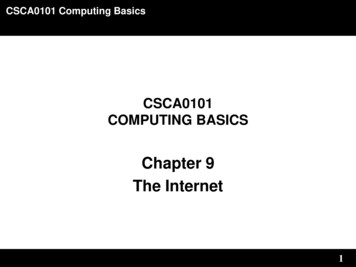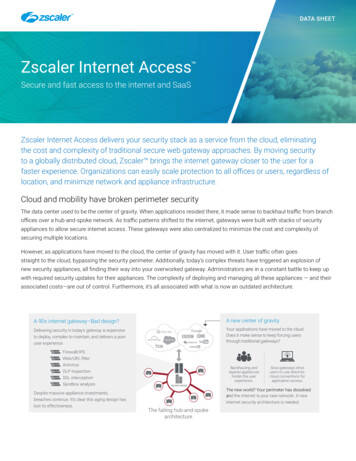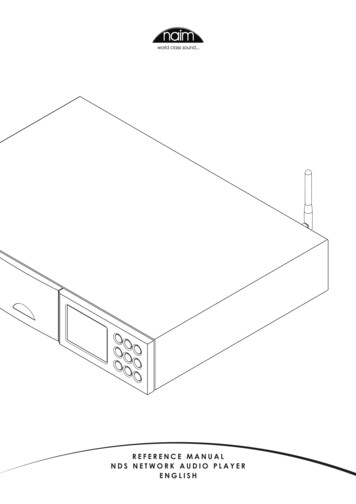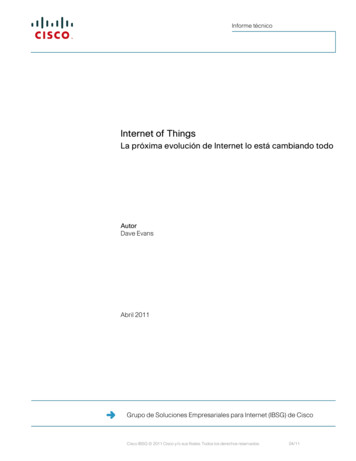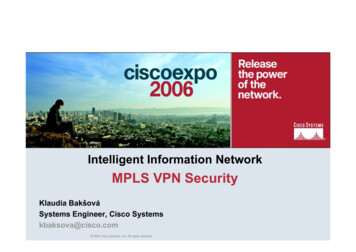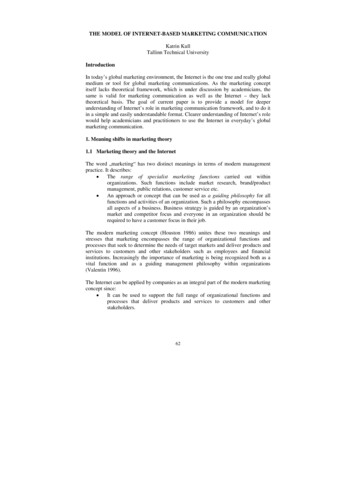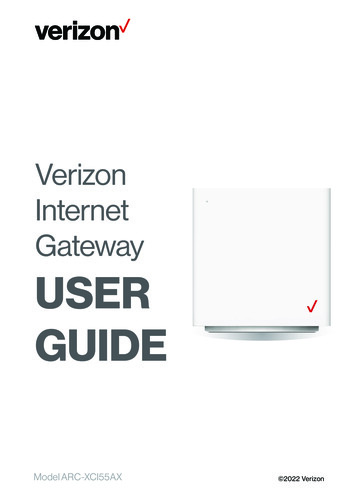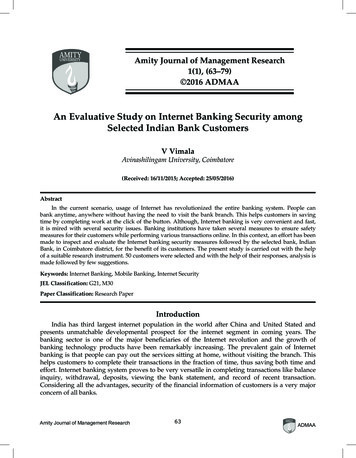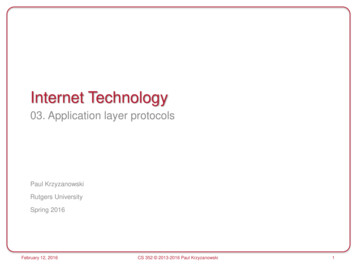
Transcription
Internet Technology03. Application layer protocolsPaul KrzyzanowskiRutgers UniversitySpring 2016February 12, 2016CS 352 2013-2016 Paul Krzyzanowski1
Today we’ll examine DNS: Domain Name System HTTP: Hypertext Transfer Protocol FTP: File Transfer ProtocolFebruary 12, 2016CS 352 2013-2016 Paul Krzyzanowski2
Domain Name SystemFebruary 12, 2016CS 352 2013-2016 Paul Krzyzanowski3
How are IP addresses assigned?IP addresses are distributed hierarchically Internet Assigned Numbers Authority (IANA) at the top– IANA is currently run by ICANN Internet Corporation for Assigned Names and NumbersRegional Internet Registries (RIR)AfriNICIANAARINAPNICRIPENCCLACNICAllocate blocks of addresses to ISPsRIR MapISPISPISPISPISPISPISPISPYour computer (or Internet gateway)- We will look at NAT later- Permanent (static) or temporary (dynamic)February 12, 2016CS 352 2013-2016 Paul Krzyzanowski4
How are machine names assigned? Early ARPANET– Globally unique names for each machine (e.g., UCBVAX)– Kept track at the Network Information Center at the StanfordResearch Institute (SRI NIC) That doesn’t scale! A domain hierarchy was created in 1984 (RFC 920)– Domains are administrative entities: divide name management– Tree-structured global name space– Textual representation of domain nameswww.cs.rutgers.eduFebruary 12, 2016CS 352 2013-2016 Paul Krzyzanowski5
Domain Name HierarchyRootcomedugovinfonetgeneric TLDsorgacaenluszwcountry-code TLDsrutgerscsFebruary 12, 2016nbwwwCS 352 2013-2016 Paul Krzyzanowski6
Top Level Domains (TLDs)ccTLDIDN ccTLDCountry-code domainsISO 3166 codesInternationalizedcountry-code domainse.g., .us, .de, .ca, .ese.g., . السعودية , .中國 , .рфgTLDGeneric top-level domainse.g., .biz, .com, .edu,.gov, .info, .net, .orgThere are currently 1,239 top-level domainsEach top-level domain has an administrator assigned to itAssignment is delegated to various organizations by the Internet AssignedNumbers Authority (IANA)See http://www.iana.org/domains/root/db for the latest countFebruary 12, 2016CS 352 2013-2016 Paul Krzyzanowski7
Shared registration Domain name registry: this is the database– Keeps track of all domain names registered in a top-level domain Domain name registry operator: this is the company that runs the db– NIC Network Information Center – organization that keeps track of theregistration of domain names under a top-level domain– keeps the database of domain names Domain name registrar: this is the company you use to register– Company that lets you register a domain nameFebruary 12, 2016CS 352 2013-2016 Paul Krzyzanowski8
Shared registration Until 1999: Network Solutions Inc. operated the .com, .org, .net registries Now– Multiple domain registrars provide domain registration services– Around 1,000 of these companies – each is accredited by the ICANN 2,124 as of February 2016, including 701 unique DropCatch.com registrars The registrar you choose becomes the designated registrar for your domain– Maximum period of registration for a domain name 10 years The registry operator keeps the central registry database for the top-level domain Only the designated registrar can change information about domain names– A domain name owner may invoke a domain transfer processExample Namecheap is the designated registrar for poopybrain.com VeriSign is the registry operator for the .com gTLDSee -list.html for the latest list of registrarsFebruary 12, 2016CS 352 2013-2016 Paul Krzyzanowski9
The problemEvery device connected to the Internet has a uniqueInternet Protocol (IP) addressHow do you resolve user-friendly machine names toIP addresses?www.cs.rutgers.eduFebruary 12, 2016128.6.4.24CS 352 2013-2016 Paul Krzyzanowski10
Original solutionThrough the 1980s– Search /etc/hosts file for machine name (see RFC 606)– File periodically downloaded from Network Information Center(NIC) at the Stanford Research Institute (SRI)– This was not sustainable with millions of hosts on the Internet A lot of data A lot of churn in the data– new hosts added, deleted, addresses changed Maintenance Traffic volumeSolution doesn’t scale!February 12, 2016CS 352 2013-2016 Paul Krzyzanowski11
DNS: Domain Name System Distributed database– Hierarchy of name servers DNS is an application-layer protocol– Name-address resolution is handled at the edge– The network core is unaware of host namesFebruary 12, 2016CS 352 2013-2016 Paul Krzyzanowski12
DNS provides Name to IP address translation Aliasing of names (called canonical names) Identification of name servers Mail server names Load distribution:– Multiple name servers that can handle a query for a domain– Caching– Ability to provide a set of IP addresses for a nameFebruary 12, 2016CS 352 2013-2016 Paul Krzyzanowski13
DNS is a distributed, hierarchical databaseRoot DNSServerscom DNSServersgoogle.comDNS Serversedu DNSServersrutgers.eduDNS Serversorg DNSServerscolumbia.eduDNS Serverspk.org DNSServersA collection of DNS serversFebruary 12, 2016CS 352 2013-2016 Paul Krzyzanowski14
Authoritative DNS server An authoritative name server is responsible for answeringqueries about its zone– Configured by the administrator Zone group of machines under a node in the treeE.g., rutgers.eduFebruary 12, 2016CS 352 2013-2016 Paul Krzyzanowski15
A DNS server returns answers to queriesKey data that a DNS server maintains (partial list)InformationAbbreviation DescriptionHostAHost address (name to address)Includes name, IP address, time-to-live(TTL)Canonical nameCNAMEName for an aliasMail exchangerMXHost that handles email for the domainName serverNSIdentifies the name server for the zone:tell other servers that yours is theauthority for info within the domainStart of ZoneAuthoritySOASpecifies authoritative server for thezone. Identifies the zone, time-to-live, andprimary name server for the zoneFebruary 12, 2016CS 352 2013-2016 Paul Krzyzanowski16
Finding your way How do you find the DNS Server for rutgers.edu?– That’s what the domain registry keeps track of– When you register a domain, you supply the addresses of at leasttwo DNS servers that can answer queries for your zone So how do you find it?– Start at the rootFebruary 12, 2016CS 352 2013-2016 Paul Krzyzanowski17
Root name servers The root name server answers can return a list ofauthoritative name servers for top-level domains 13 root name servers– A.ROOT-SERVERS.NET , B.ROOT-SERVERS.NET , – Each has redundancy (via anycast routing or load balancing)Download the latest list at http://www.internic.net/domain/named.rootFebruary 12, 2016CS 352 2013-2016 Paul Krzyzanowski18
DNS Queries Iterative (non-recursive) name resolution– DNS server will return a definitive answer or a referral to another DNS server referral reference to a DNS server for a lower level of the queried namespace Server returns intermediate results to the client1. Send query to a root name server2. Send query to a edu name server3. Send query to a rutgers name server– Advantage: stateless Recursive DNS name resolution– Name server will take on the responsibility of fully resolving the name May query multiple other DNS servers on your behalf– DNS server cannot refer the client to a different server– Disadvantage: name server has more work; has to keep track of state– Advantages: Caching opportunities, less work for the client!Most top-level DNS servers only support iterative queriesFebruary 12, 2016CS 352 2013-2016 Paul Krzyzanowski19
DNS Resolvers: local name server DNS Resolver– Not really a part of the DNS hierarchy– Acts as an intermediary between programs that need to resolve names and thename servers– A resolver is responsible for performing the full resolution of the query Where are they?– Local system has one: that’s what applications contact Local cache; may be a process or a library On Linux & Windows, these are limited DNS servers (called stub resolvers): they are notcapable of handling referrals and expect to talk with a name server that can handle recursion(full resolution)– ISPs (and organizations) run them on behalf of their customers Including a bunch of free ones (OpenDNS, Google Public DNS) Resolvers cache past lookups – not responsible for zonesFebruary 12, 2016CS 352 2013-2016 Paul Krzyzanowski20
Using a DNS resolverTo look up a name:– Send a DNS query to the local resolver (recursion requested) Local resolver– If the local resolver has cached results, it can return the answer– Otherwise, consult a local hosts file (e.g., /etc/hosts) to return locallyconfigured name address mappings– Otherwise contact a DNS server that the client knows about – this istypically another resolver that is provided by the ISP The local system is configured with one or more addresses of external nameservers ISP Resolver– Check cache– Check a locally-configured zone file (if any). If the desired data is there,return an authoritative answer– Otherwise, do an iterative set of queries to traverse the hierarchy to findthe desired name server and get resultsFebruary 12, 2016CS 352 2013-2016 Paul Krzyzanowski21
DNS Resolvers in actionLocal serverISPappDNS stubresolverDNSresolverappcachecache/etc/hostszone infoLocal stub resolver:- check local cache- check local hosts file- send request to external resolverInterativelookupDNS hierarchyExternal resolver- DNS server that accepts recursion- Running at ISP, Google Public DNS,OpenDNS, etc.E.g., on Linux: resolver is configured viathe /etc/resolv.conf fileFebruary 12, 2016CS 352 2013-2016 Paul Krzyzanowski22
Sample query Rutgers registered rutgers.edu with the .edu domain– educause.net is the domain registry for the .edu gTLD The root name server contains addresses for the nameservers of all the top-level domains The local name server is provided the list of addresses ofroot name serversFebruary 12, 2016CS 352 2013-2016 Paul Krzyzanowski23
Sample QuerySubmit query to a local DNS resolver:1.Send query(cs.rutgers.edu) root name serverroot name servers identify authoritative servers for top-level domainssend query to c.root-servers.net: 192.33.4.122.Receive referral to a list of DNS servers for edua.edu-servers.net: 192.5.6.30g.edu-servers.net: 192.42.93.303.Send query(cs.rutgers.edu) edu name serversend query to g.edu-servers.net: 192.41.162.324.Receive referral to rutgers.edu name servers:- ns87.a0.incapsecuredns.net 192.230.121.86- ns8.a1.incapsecuredns.net.192.230.122.7- ns124.a2.incapsecuredns.net 192.230.123.1235.query(cs.rutgers.edu) rutgers name serversend query to 192.230.122.76.The rutgers name server returnsA: 128.6.4.2addressMX: dragon.rutgers.edu domain name for emailFebruary 12, 2016CS 352 2013-2016 Paul Krzyzanowski24
Caching Starting every query at the root would place a huge loadon root name servers A name server can be configured to cache results ofprevious queries– Save query results for a time-to-live amount of time– The time-to-live value is specified in the domain name record by anauthoritative name server Caching name servers are recursive name serversFebruary 12, 2016CS 352 2013-2016 Paul Krzyzanowski25
The DNS Query ProtocolFebruary 12, 2016CS 352 2013-2016 Paul Krzyzanowski26
DNS Records DNS servers store resource records (RRs) Format– Name, value, type of record, TTL (time to live) Common types– Canonical name: CNAME– Address: A Name: alias hostname Value: real hostname Name: hostname Value: IP address– Mail Exchanger: MX– Name Server: NS Name: domain (rutgers.edu) Value: hostname of authoritativename server for the domainFebruary 12, 2016 Name: hostname Value: mail server for hostnameCS 352 2013-2016 Paul Krzyzanowski27
DNS Protocol DNS is a service that listens to requests on TCP or UDP port 53 Protocol consists of query and reply messages– Both messages have the same format and headerIdentification16 bit number for query.Matching number for reply.IdentificationFlagsNumber ofquestionsNumber of answerRRsIdentificationNumber ofadditional RRs12 bytesQuestions(variable # of questions)FlagsQuery or reply (request/response)Recursion desired (request)Recursion available (response)Reply is authoritative (response)Answers(variable # of resource records)Authority(variable # of resource records)Additional Information(variable # of resource records)February 12, 2016CS 352 2013-2016 Paul Krzyzanowski28
DNS Protocol DNS is a service that listens to requests on TCP or UDP port 53 Protocol consists of query and reply messages– Both messages have the same format and headerName, type fields for a queryResource records inresponds to queryRecords for authoritativeserversAdditional helpful information(e.g., other DNS servers indomain)February 12, 2016IdentificationFlagsNumber ofquestionsNumber of answerRRsIdentificationNumber ofadditional RRs12 bytesQuestions(variable # of questions)Answers(variable # of resource records)variableAuthority(variable # of resource records)Additional Information(variable # of resource records)CS 352 2013-2016 Paul Krzyzanowski29
DNS Queries Questions field contains a sequence or DNS queries Query name– Encoded form of the name for which we want an address Query type– 1 IP address, 2 name server, 0x0f mail server, Query class– 1 Internet addresses, 2 CSNETQNAME (variable)QTYPE(16 bits)February 12, 2016CS 352 2013-2016 Paul KrzyzanowskiQCLASS(16 bits)30
Reverse DNS What if we have an IP address and want the name? Special domain for reverse lookups– in-addr.arpa– ARPA Address & Routing Parameter Area,not Advanced Research Projects Agency (e.g., ARPANET)www.cs.rutgers.edu 128.6.4.2424.4.6.128.in-addr.arpa www.cs.rutgers.eduFebruary 12, 2016CS 352 2013-2016 Paul Krzyzanowski31
Setting up reverse DNS Different query path than regular DNS queries On a DNS server– Configure PTR (pointer) records that map IP addresses to names Let the world find out– ISP allocated IP addresses to you– You tell the ISP what DNS servers are responsible for reverse DNSentries Example query path– DNS resolver contacts root servers– Root server refers to ARIN (North American IP registry) RDNS server– ARIN refers to local ISP RDNS server, which refers to your serverRoot server RIR (e.g., ARIN) DNS server ISP DNS serverFebruary 12, 2016CS 352 2013-2016 Paul Krzyzanowski32
Web and HTTPFebruary 12, 2016CS 352 2013-2016 Paul Krzyzanowski33
HTTP Basics HTTP: Hypertext Transfer Protocol (RFC 2616)– Web’s application-layer protocol– Client-server model– TCP-based protocol Client connects to port 80 on the server HTTP messages are exchanged Client closes the connectionHTTP Server(e.g., Apache) HTTP is stateless– Server does not store stateon previous requests– Simplifies design Easier failure recovery Simplifies load balancingFebruary 12, 2016HTTP Client(e.g., Safari)CS 352 2013-2016 Paul Krzyzanowski34
URLs Requests for objects are URLs URL Uniform Resource Locatorhttp://domain name:port/path/path/objectprotocolserverport #path to tuff.htmlFebruary 12, 2016CS 352 2013-2016 Paul Krzyzanowski35
Types of connections Non-persistent HTTP (HTTP 1.0)– At most one object is sent over a TCP connection– Request/response Persistent HTTP (HTTP 1.1)– Multiple objects can be sent over a single connectionFebruary 12, 2016CS 352 2013-2016 Paul Krzyzanowski36
Non-persistent HTTP www.pk.org/index.html is one file that references:– Five CSS (cascading style sheet) files– Four image files1aHTTP client connects to www.pk.org on port 801b2HTTP client sends a request message to get theobject index.html34HTTP server accepts the connectionHTTP client receives the response & parses it.Realizes that it needs to get 9 more objects.5HTTP server forms a response message containingthe requested object and sends it to the clientHTTP server closes the connectionRepeat steps 1-5February 12, 2016CS 352 2013-2016 Paul Krzyzanowski37
Non-persistent HTTP: Response time Round-trip time (RTT)– Time for a small packet to travel from theclient to the server & back to the clientConnect Response time– One RTT to initiate the connection– One RTT for request & start of responseRTTRequest fileRTT– File transmission time Total time # objects (2 RTT transit time)Time totransmitfileFile receivedConnectRTTRequest fileRTTTime totransmitfileFile receivedFebruary 12, 2016CS 352 2013-2016 Paul Krzyzanowski38
Persistent HTTP: Response time Server leaves connection open after sendingresponse– Subsequent HTTP messages are sent over the sameopen connection– One RTT for each referenced object once theconnection is set upConnectRTTRequest file Response time– One RTT to initiate the connection– One RTT for request & start of response perobject– File transmission time per object Total timepersistent RTT # objects (RTT transit time)RTTTime totransmitfileFile receivedRTTTime totransmitfileFile received Versus Total timenon-persistent # objects (2 RTT transit time)February 12, 2016CS 352 2013-2016 Paul Krzyzanowski39
HTTP Request Message Two classes of messages: request & response HTTP request messages are human-readable ASCII textBrowser request for a URL (Uniform Resource mlheadersCreates an HTTP requestRequest line: GET, POST, HEAD, commandsGET /this/is/a/test.html HTTP/1.1Host: box.pk.org:12345User-Agent: Mozilla/5.0 (Macintosh; Intel Mac OS X 10 8 2) AppleWebKit/536.26.17(KHTML, like Gecko) Version/6.0.2 Safari/536.26.17Accept: text/html,application/xhtml xml,application/xml;q 0.9,*/*;q 0.8Accept-Language: en-usAccept-Encoding: gzip, deflateConnection: keep-aliveCarriage return, line feed (0x0d, 0x0a) indicates endof header and end of message in this caseFebruary 12, 2016CS 352 2013-2016 Paul Krzyzanowski40
HTTP Response MessageheadersStatus line:Protocol, status code, status textHTTP/1.1 200 OKDate: Mon, 11 Feb 2013 19:31:58 GMTServer: Apache/2.2.22 (Ubuntu)Last-Modified: Thu, 31 Jan 2013 01:18:12 GMTETag: "3c0549-17df-4d48b667f3d00"Accept-Ranges: bytesContent-Length: 6111Vary: Accept-EncodingConnection: closeContent-Type: text/htmlCarriage return, line feed(0x0d, 0x0a) indicates endData (e.g., web page content)of headerFebruary 12, 2016CS 352 2013-2016 Paul Krzyzanowski41
Uploading form input HTTP POST method– Web pages may include form input– Input is uploaded to the server in the body of the request URL method– Parameter/value pairs are encoded in the URL (query string)– HTTP GET request is sent– Format http://server/path/page?query string query string is of the form item0 value0&item1 value1.February 12, 2016CS 352 2013-2016 Paul Krzyzanowski42
HTTP MethodsHTTP/1.0HTTP/1.1 GET GET, POST, HEAD– Request a resource PUT POST– Send data in the requestmessage’s body to the server HEAD– Like GET, but only send theheadersFebruary 12, 2016– Uploads file to the pathspecified in the URL field DELETE– Deletes the file specified inthe URL fieldCS 352 2013-2016 Paul Krzyzanowski43
Some HTTP response codes 200 OK– Request succeeded; requested object is in the message 301 Moved Permanently– Requested object moved; new location specified in a Location:header in the list of headers 400 Bad Request– The server could not understand the request 404 Not Found– The requested content is not found on the server 505 HTTP Version Not Supported– Unsupported versionFebruary 12, 2016CS 352 2013-2016 Paul Krzyzanowski44
Try it out yourselfTalk to a serverListen to a client Run Run demo TCP server– telnet cnn.com 80– java TCPServer Type in a basic GET request Start a browser and connect to it:– GET /index.html HTTP/1.1– http://localhost:12345/a/b/c– Followed by an blank line– The server will print all the data it getsfrom the client Look at the responseFebruary 12, 2016CS 352 2013-2016 Paul Krzyzanowski45
Keeping state: cookies HTTP is stateless Cookies provide a mechanism for web servers to store state Four parts to cookies:1.Cookie header line in the HTTP response message2.Cookie header line in subsequent HTTP request messages3.Cookie file stored on user’s host & managed by browser4.Back-end database at the web server host Example– You visit an e-commerce site– When the site receives your request, it creates a unique ID and an entry inthe database identified by that ID.– The HTTP response tells your browser to set a cookie. The cookie is sentwith future messages to that serverFebruary 12, 2016CS 352 2013-2016 Paul Krzyzanowski46
Cookies in useclientebay.com: 9123serverHTTP requestamazon.comcreates an ID 2244for the requestebay.com: 9123amazon.com: 2244HTTP responseSet-cookie: 2244HTTP requestCookie: 2244Cookie-specificactionHTTP requestCookie: 2244Cookie-specificactionDatabaseFuture sessionebay.com: 9123amazon.com: 2244February 12, 2016CS 352 2013-2016 Paul Krzyzanowski47
Maintaining state with cookies Cookies can help a server store & access–––––Shopping cart infoLogin name, authorization credentialsPreferences (e.g., town name for weather)Session state (e.g., web-based email)History of web pages you visited on the site First-party cookies– Placed by the website you visit Third-party cookies– Placed by sites other than the one you visit – mostly adsFebruary 12, 2016CS 352 2013-2016 Paul Krzyzanowski48
Web caching: proxy servers Caching proxy User sends all HTTP requests to a proxy server Proxy server:– Checks its cache– If the response is cached, it returns an HTTP response– If not, it contacts the server Server sends a response Proxy caches it Proxy forwards the response to the requesting client AdvantagesCaching proxyacts as both aclient & serverWeb serverProxy– Reduce response time if proxyis closer/faster– Reduce traffic on the web server– Reduce traffic on the organization’s linkFebruary 12, 2016CS 352 2013-2016 Paul Krzyzanowski49
Caching example AssumeServers on the public Internet– Average object size 1 Mbit ( 122KB)– Average request rate from institution’sbrowsers to servers 15/s– Delay from institutional router to a server andback to router 2 sec Consequences15 Mbpsaccess link– Utilization on LAN 1.5%– Utilization on access link 100%– Total delay Internet delay access delay LAN delay2 sec2 secminutesTraffic intensity on access link (15 requests/sec) (1 Mbits/request)/(15 Mbps) 1100 Mbps LANmsecTraffic intensity on LAN (15 requests/sec) (1 Mbits/request)/(100 Mbps) 0.15Traffic intensity 1 BAD delay grows without bound (minutes!)February 12, 2016CS 352 2013-2016 Paul Krzyzanowski50
Caching example: improve access link AssumeServers on the public Internet– Access link is now 100 Mbps Consequences– Utilization on LAN 1.5%– Utilization on access link 15%– Total delay Internet delay access delay LANdelay 2 sec msec msec– But increasing the access link can be acostly upgradeFebruary 12, 2016CS 352 2013-2016 Paul Krzyzanowski100 Mbpsaccess link100 Mbps LAN51
Caching example: add a caching proxy AssumeServers on the public Internet– Access link remains at 15 Mbps– Install a caching proxy– Assume hit rate is 0.4 (40% hits) Consequences– 40% of requests satisfied by proxy(quick – e.g., 10 ms)– 60% have to go to outside servers15 Mbpsaccess link– Use of access link reduced to 60%– Total average delay Internet delay access delay LANdelay 0.6*(2.01 s) 0.4*(10 ms) puny ms 1.4 secondsFebruary 12, 2016CS 352 2013-2016 Paul KrzyzanowskiCachingproxy100 Mbps LAN52
HTTP control for cachingConditional GET– Request an object BUT don’t send it if the cache has an up-to-date versionHTTP RequestGET /index.html HTTP/1.1Host: box.pk.orgHTTP ResponseTimestamp of file modification on serverHTTP/1.1 200 OKDate: Mon, 11 Feb 2013 21:01:16 GMTServer: Apache/2.2.22 (Ubuntu)Last-Modified: Thu, 31 Jan 2013 01:18:12 GMTETag: "3c0549-17df-4d48b667f3d00"Accept-Ranges: bytesContent-Length: 6111Unique string for that version ofVary: Accept-Encodingthe file; typically a hash of the fileContent-Type: text/htmlTo cache, store the file, Last-Modified timestamp, and ETag.Content February 12, 2016CS 352 2013-2016 Paul Krzyzanowski53
HTTP control for cachingNext time you request the file, include two headers in your requestIf-Modified-Since: time from Last-ModifiedIf-None-Match: value from EtagHTTP RequestGET /index.html HTTP/1.1Host: box.pk.orgIf-Modified-Since: Thu, 31 Jan 2013 01:18:12 GMTIf-None-Match: "3c0549-17df-4d48b667f3d00"HTTP ResponseHTTP/1.1 304 Not ModifiedDate: Mon, 11 Feb 2013 21:11:32 GMTServer: Apache/2.2.22 (Ubuntu)ETag: "3c0549-17df-4d48b667f3d00"Vary: Accept-EncodingFebruary 12, 2016This means the file was notmodified since the cached copy.– alternatively –If the content has beenmodified at the server, thenthe content is sent as with anormal GET request.CS 352 2013-2016 Paul Krzyzanowski54
Conditional GET Request a file from a server because it’s not in your cache– Receive the file– Headers contain: Last-Modified and Etag– For caching, store both of those along with the file Next time you request the file, include two headers in your request– If-Modified-Since: time from Last-Modified – If-None-Match: value from Etag If the file has changed since you last requested it, the server will sendback the new file. If not, the server will respond with a “304 NotModified” codeFebruary 12, 2016CS 352 2013-2016 Paul Krzyzanowski55
More Optimizations Problem: Head-of-line blocking– One large (or slow) HTTP request can hold up all other requests from that client HTTP/1.x: Parallel connections– Open multiple TCP connections to the server– But: Hard to deploy with proxies Each connection takes time to open Can use up a lot of connections – extra server memory– Parallel connections typically limited to a small number (e.g., 4) Can still lead to head-of-line blocking per connection HTTP/1.x: Pipelining– Send multiple HTTP requests without waiting for a response from each one– But: The server still must send responses in the order requests were sent Requests may be received quicker by the server but responses are still at risk of head-of-lineblocking Not supported or turned on in most browsers and proxiesFebruary 12, 2016CS 352 2013-2016 Paul Krzyzanowski56
More Optimizations HTTP/2 – Multiplexing– Multiple request & response messages can be in flight at the same time– Messages can be intermingled on one connection “Minification”– Reduce unnecessary characters form JavaScript & CSS– Merge multiple script files into one compressed file HTTP/2 – header compression– Each HTTP header uses 1400 bytes – takes 7-8 round trips to move them to theclient HTTP/2 – server push– Server can push content – give the client more than what it requested– Why send more data? The browser has to get the first response, parse it, and make requests But the server knows what a browser will need to render a web page– It can send the data before it’s requested by the clientFebruary 12, 2016CS 352 2013-2016 Paul Krzyzanowski57
FTP: File Transfer ProtocolFebruary 12, 2016CS 352 2013-2016 Paul Krzyzanowski58
FTP: File Transport Protocol Transfer files between computers Client/server model Client: accepts commands from the user and initiates requests to getor put files on the server Defined in RFC 959– Original version RFC 765 – June 1980– First proposal dates back to 1971FTPclientSend/receive filesFTPserverfilesFebruary 12, 2016CS 352 2013-2016 Paul Krzyzanowski59
Separate data & control connections Client connects to an FTP serveron TCP port 21– This is the command channel– Client port some port 1024 N Commands are user requests andinclude authentication info When the server receives acommand to transfer data, itinitiates a TCP connection to theclient on port N 1 from its localdata port (20) After transferring one file, theserver closes the data connectionFebruary 12, 2016filesconnectPort NFTPclientcommandsPort 21dataPort N 1Port 20FTPserverconnectSeparation between control &data channels– Out of band control connectionCS 352 2013-2016 Paul Krzyzanowski60
Sample FTP Commands Sent as ASCII text over thecontrol channel– Similar to HTTP: Status code & text Access commands– 331 User name okay, need password.– USER: identify yourself– PASS: supply your password– CWD (CD): change working directory– CDUP (CD .): change to parent– QUIT: log out Error messages– 200 Command okay.– 230 User logged in, proceed.– 502 Command not implemented.– 125 Data connection already open;transfer starting. Control commands– RETR (GET): retrieve a file– STORE (PUT): store a file– APPEND: append to a file– DELETE: delete a file– LIST (DIR): list filesFebruary 12, 2016CS 352 2013-2016 Paul Krzyzanowski61
Active vs. Passive FTP Not all clients can receive incoming connections– This was a pain with firewalls and NAT (network address translation) Passive mode FTP– Client initiates both connections to the server– The first connection (for commands) contacts the server on port 21 Originating port N, N 1024– Then the client then issues a PASV command The server opens a random port P 1024 Sends back the value P to the client as a response The client then connects from port N 1 to port P Most browsers support only passive mode FTPFebruary 12, 2016CS 352 2013-2016 Paul Krzyzanowski62
The endFebruary 12, 2016CS 352 2013-2016 Paul Krzyzanowski63
Shared registration Domain name registry: this is the database - Keeps track of all domain names registered in a top-level domain Domain name registry operator: this is the company that runs the db - NIC Network Information Center - organization that keeps track of the registration of domain names under a top-level domain

